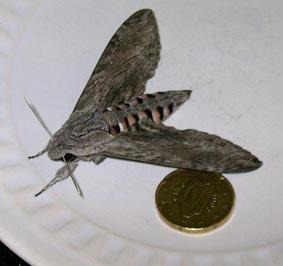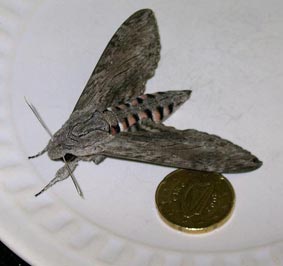Moth the hell?

Éanna Ní Lamhna explains the mystery of the massive hawk moth
Season of mists and mellow fruitfulness. At the end of September there was an influx of large moths into Ireland. Ordinary decent folk encountered these in their gardens, on electricity poles, among the clothes gathered in from the line and were flabbergasted. They had never seen the like – neither colour, shape nor, more particularly, size. And worst of all they were encountered in daylight – the things hadn't even the decency to wait for the cover of darkness. What are they and why are they here?
It is the perfectly harmless Convolvulus Hawk moth.
This hawk moth likes warmer climes than Ireland and occurs in the Mediterranean regions of Europe, where it breeds – laying its eggs on species of bindweed – Convolvulus as it is called in Latin. By late summer its population rises considerably and the more adventurous of them spread their wings and fly northwards. This population expansion usually only gets as far as France or southern England – but this year the moths seem to have leapt out of their latitude entirely and descended on our shores in considerable numbers during the month of September.
As can be seen from the accompanying photograph, it is a big moth. It has a wingspan of 11cm – the biggest of all the moths here. Its body, five centimetres long, is adorned with characteristic stripes of orangey pink and black, with a cream coloured one at the top of the abdomen giving the game away and confirming that it is a Convolvulus moth and not a privet one, which is pinker and lacks such a stripe.
Its caterpillars feed on that terrible bindweed gardeners hate to growing – the one with the white trumpet shaped flowers – so isn't it grand that such a striking-looking adult has such useful caterpillars. However it is so late getting here that it usually doesn't get to complete any life-cycle before winter sets in – and indeed the chilly winds of October have already arrived. But give global warming another few years and we may yet be fearing for our bindweed as it is munched by hordes of huge convolvulus caterpillars.
